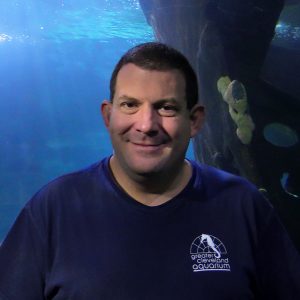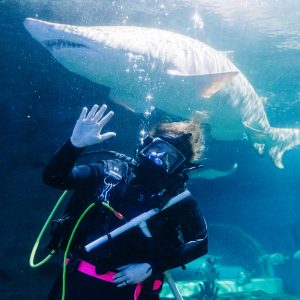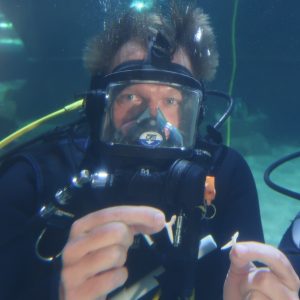Best Places to Dive: Fiji Islands
 Nicknamed the “Soft Coral Capital of the World” by none other than famous oceanographic explorer Jean-Michel Cousteau (son of Jacques), the islands of Fiji are a year-round diving destination filled to the brim with assorted sea life.
Nicknamed the “Soft Coral Capital of the World” by none other than famous oceanographic explorer Jean-Michel Cousteau (son of Jacques), the islands of Fiji are a year-round diving destination filled to the brim with assorted sea life.
Greater Cleveland Aquarium diver Craig Zwegat has over 700 dives in his 14 years of diving, so he knows a thing or two about exotic dive locations. His visit to the Fiji Islands was memorable both for the wonders under the water as well as how he was embraced by the local Fijian culture. Read any dive guide of the area and they can’t help but insert a comment about how welcoming and friendly the locals are to their guests. A 2014 Gallup Poll even named Fiji the happiest country in the world.
The Republic of Fiji consists of approximately 320 islands in the South Pacific, of which about one hundred are inhabited. The indigenous name of the islands is Viti, an Austronesian word meaning “east” or “sunrise”, which makes sense as the closest continent, Australia, lies almost 3,000 miles west of Fiji, roughly a four-hour plane ride.
The islands are well-known for their soft corals that wave in the current like so many giant, techno-colored fans and fingers. Every kind of tiny prey fish imaginable hide within these corals, attracting larger and larger predators to the area for a diver’s viewing pleasure. At the top of the food chain, divers have enjoyed swimming with tiger sharks, bull sharks, and giant hammerheads.
Dive operations are largely run out of the two largest Fiji Islands, Viti Levu (“Great Fiji”) and Vanua Levu (“Great Land”), which then launch to many of the smaller islands known for certain specialty dives. Taveuni Island is known for the “Great White Wall,” an almost vertical wall blanketed in coral that starts at 80 feet and goes far beyond recreational limits. For those seeking sharks, Viti Levu has an 80-foot dive known for bull and tiger sharks as well as nurse, lemon and reef sharks. Kadavu Island, directly south of Viti Levu, is the place to find manta rays as well as giant ocean predators like tuna and marlin. Drift divers will enjoy spotting octopuses, crabs and eels as they zip along the underwater currents off Vanua Levu. And just a few kicks off each island are those famous soft corals.
“Ni sa bula Vinaka” means hello in Fijian, or “Wishing you happiness and good health.” It’s a long flight from the US, about 11 hours from LAX to Nadi Airport, but what diver worth their salt wouldn’t want to follow in Jean-Michel Cousteau and Craig Zwegat’s footsteps and visit this diving nirvana?
Kona, Hawaii is the eighth in our weekly series of the Aquarium dive team’s favorite dive locations. Stay tuned for the remaining two destinations and suggest somewhere new we might want to explore.

 A shade over 66 million years ago, a six-mile-wide meteor came screaming out of the heavens at 12 miles per second and a 60-degree angle to the surface of the Earth, which is kind of a worst-case scenario angle in terms of plunging chunks of space rock. It absolutely pulverized the impact zone with the force of a 100 million megaton bomb, creating tsunamis hundreds of feet high and flinging rocks half a continent away. For non-avian dinosaurs, the impact marked the end of an era. Literally. This is where the Mesozoic Era ended, and the Cenozoic began—the infamous K-T Extinction that eliminated roughly 80 percent of all species on the planet.
A shade over 66 million years ago, a six-mile-wide meteor came screaming out of the heavens at 12 miles per second and a 60-degree angle to the surface of the Earth, which is kind of a worst-case scenario angle in terms of plunging chunks of space rock. It absolutely pulverized the impact zone with the force of a 100 million megaton bomb, creating tsunamis hundreds of feet high and flinging rocks half a continent away. For non-avian dinosaurs, the impact marked the end of an era. Literally. This is where the Mesozoic Era ended, and the Cenozoic began—the infamous K-T Extinction that eliminated roughly 80 percent of all species on the planet. When
When  We dive for a variety of reasons. To commune with nature, to unwind, to explore. Our “pale blue dot,” as astrophysicist and author Carl Sagan pointed out, is just a “very small stage in a vast cosmic arena,” but perhaps by diving in we can learn to better appreciate that fragile ecosystem largely invisible to us as we commute between school, work and the grocery store in our busy daily lives.
We dive for a variety of reasons. To commune with nature, to unwind, to explore. Our “pale blue dot,” as astrophysicist and author Carl Sagan pointed out, is just a “very small stage in a vast cosmic arena,” but perhaps by diving in we can learn to better appreciate that fragile ecosystem largely invisible to us as we commute between school, work and the grocery store in our busy daily lives. Scuba diving and Cleveland, Ohio . . . sort of go together like peanut butter and monkey wrenches, right? I challenge you to find one of those “101 Places to Dive Before You Die” books with a cover that isn’t turquoise, tropical and filled with colorful reef fish. And yet Cleveland has its own extensive dive community. Lake Erie, the shallowest of the Great Lakes, has hundreds of shipwrecks to explore and is serviced by several dive shops that teach classes, sell gear, and organize trips all over the world. Northeast Ohio is home to around 4.5 million people and an untold amount of scuba divers who love to explore the waters in their own backyard as well as adventure to distant places to see what there is to see in the 70% of our planet that is underwater.
Scuba diving and Cleveland, Ohio . . . sort of go together like peanut butter and monkey wrenches, right? I challenge you to find one of those “101 Places to Dive Before You Die” books with a cover that isn’t turquoise, tropical and filled with colorful reef fish. And yet Cleveland has its own extensive dive community. Lake Erie, the shallowest of the Great Lakes, has hundreds of shipwrecks to explore and is serviced by several dive shops that teach classes, sell gear, and organize trips all over the world. Northeast Ohio is home to around 4.5 million people and an untold amount of scuba divers who love to explore the waters in their own backyard as well as adventure to distant places to see what there is to see in the 70% of our planet that is underwater.